Papa Damballah the Serpent
Damballah (also Danbala in Creole) is one of the most important Lwa, or spirits, in Voodoo. As Voodoo is a tradition with many paths, there are many different stories of Damballah. In some, Damballah is the Lwa who created the universe and all things. In others, Damballah was the first being and Lwa created by God, the Bon Deu, or Bondye. In the creation stories, Damballah created the earth and universe with his body. All of material reality was formed by the coils of Damballah’s tail, for he is a serpent. The stars of the sky are said to be his scales, or his body.
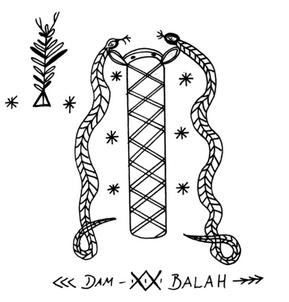
It is important to understand the serpent motif in African (and world) spirituality. In the Western Judeo-Christian tradition, the serpent is usually associated with negative forces. For example, we see the serpent as the tempter of Adam and Eve in the Bible. In some traditions the serpent is sometimes associated with the Devil, Lucifer or Satan, in others the serpent is merely a tempter.
In pre-Christian and African religion there is no negative association with the serpent. The serpent is instead associated with calmness and wisdom. He is a quiet and peaceful observer. The serpent is extremely powerful and can overcome even the mightiest of animals, yet the serpent is never deliberately aggressive, he only defends himself. The serpent is a guardian of both land and water, he can move easily through both. In Voodoo, all waters are said to be created by Damballah’s shedding of skin.
Damballah is a highly benevolent Lwa. He is in fact one of the few Lwa that are almost entirely benevolent. For this he sits firmly in the Rada family, or cool spirits, of Lwa. Damballah is also called a root Lwa, for he is one of the oldest (in fact, most likely the very oldest) of the Lwa.
The Lwa Ayida Weddo is the wife of Damballah. Together, these two Lwa represent the union of a husband and a wife. They also represent the creation of new life. This is why both Damballah and Ayida Weddo are asked for help with relationships, love, marriage and childbirth. In some of the various veve of Damballah, as well as other artistic representations, the pair are depicted together as intertwined serpents.
Damballah is less directly personal than most Lwa. Although Damballah is called upon for assistance and evoked in many rituals, he is often not the Lwa directly responsible for the outcome of a spell. Yet at the same time, Damballah exists as the primary and raw creative force of the universe. He is the one who grants the raw energy and spiritual power that all rituals and magic rely upon. Thus Damballah is often described as the primordial creative force of the universe. He is the fabric of the energy and magic that goes into spell work, or the source of that energy.
As Damballah is a grand root Lwa, he is often most apt for rituals with big goals. In many cases, asking Damballah for a large goal is better than asking for a small one. He is more likely to ignore trivial problems and more likely to help with serious problems. This is why knowing which Lwa to ask for help is important. Many are perfectly willing to help with small or trivial matters, while some will ignore them and only help with large matters. Damballah is a Lwa for large matters.
While many Lwa communicate directly to us with words, Damballah does not. If he vocalizes, it is in the hisses of a serpent. More often, Damballah appears in symbols and visions within dreams.
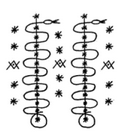
In Voodoo’s syncretism with Catholicism, Damballah is associated with Moses, or with St. Patrick. We see in the Biblical story that Moses held power over serpents. In the battle between Moses and the magicians of the Pharaoh, Moses made his staff become a serpent that swallowed the lesser serpents conjured by Pharaoh’s magicians. In the case of St. Patrick, he is said to have driven the snakes out of Ireland. Due to their associations with serpents, Moses and St. Patrick were chosen as syncretic with Damballah.
Damballah’s Offerings
Damballah’s most prominent symbol is the serpent. Any container of water, from jug to bath, is also a symbol of Damballah. In many temples to Damballah a sink will be installed as an altar or place for him. Items made of the metal silver are used in rituals with Damballah. Occasionally a machete is used as a symbol of Damballah, but this is not common. The tree is a prominent symbol of Damballah. The tree is representative both of the world tree from which all life and creation springs, as well as being the common resting place or habitat of the worldly serpent. The tree is thus sacred to Damballah, as are particular water or aquatic locations with many trees, such as swamps or marshes.
The colors most often associated with Damballah are white and silver. White as a symbol of wisdom and purity. White also because it is a symbol of life and creation, as well as death and rebirth.
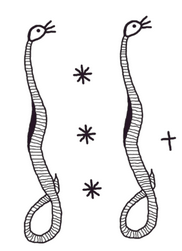
In addition to white and silver, the rainbow as a color scheme, as well as a natural phenomenon, is also associated with Damballah. We can attribute this in part to Ayida Weddo, the wife of Damballah. The rainbow is her symbol and she is said to be the rainbow itself. An additional part of the association is the Voodoo tradition that says Damballah guards the treasure at the end of the rainbow. (This may remind you of the Irish tradition of a spirit, depicted as a leprechaun, guarding a treasure at the end of the rainbow. Here we see a curious similarity between two traditions that were geographically distinct from one another). The rainbow is further symbolic of the connection between earth and sky that Damballah presides over. It is said to be his body, connecting heaven and earth. Indeed, the body of Damballah is depicted either as white or rainbow-colored, as if seen through a prism.
Damballah’s offerings reflect his favorite colors. Most offerings will be white foods. These include eggs, sugar, milk, rice, flour and foods cooked of those products. The egg is prime, both as a whole egg and as the raw white of the egg. Just as the natural serpent eats eggs, so do the servants of Damballah consume the eggs offered to him. An egg resting on a mound of flour is a common sight in altars to Damballah.
While many Lwa accept tobacco and smoke as offerings, Damballah is one of the few who is averse to smoke. He will not prefer white cigarettes or incense for example. He is also averse to offerings of alcohol, again unlike many Lwa who love alcohol.
Whatever offerings are chosen for Damballah, they must be clean, as must be his altar. This is not the case with many Lwa. A few prefer a messy or dirty altar. Damballah not so. He demands cleanliness and purity from those who would commune with him. For this reason, any speech near an altar or veve of Damballah should also be pure. It should be polite and free of profanity.
Damballah’s Veve
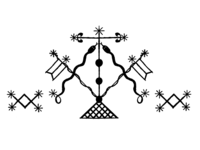
Veve of Damballah are highly variable, so you may see multiple different veve if you search for them. In all of them a prominent feature will be two snakes, representing Damballah and his wife, Ayida Weddo. Veve of Damballah may feature stars, reflecting Damballah’s role as a cosmic force.
Central to most veves of Damballah will be a line or a pole. In this symbol we see the tree of Damballah. It is also a line that connects the heaven and the earth, or the sky and the water. This is reminiscent of the caduceus, which was the Greek symbol of Hermes, often used today as a standard medical symbol.
As a central piece of the veve, in place of a tree or line we may see a chalice, goblet or long glass. In this style of veve we see Damballah’s association with water. Eggs, a favorite offering of Damballah, may also feature prominently in some veve.
A Song of Damballah
In Haitian Creole:
Kulev, kulevo
Danballah wedo, papa
U kulevo
Kulevo, kulevo
Mape reie kulevo
Kulev pa se paie
Danballah pap u se kulev
Si nu wekulev
U we Ayida Weddo
Siu we kulev
U we Danballah
Ayida Weddo se nu kulevo
English translation:
Serpent, serpent
Damballah-wedo, father
You are a serpent
Serpent, serpent
I will call the serpent
The serpent does not speak
Damballah, father, you are a serpent
If you see a snake
You see Ayida Weddo
If you see a snake
You see Damballah
Ayida Weddo is a snake
Yours,
Emmanuel A.E.


